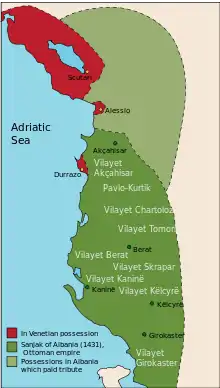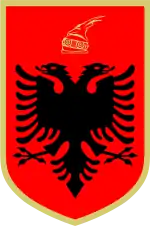Sanjak of Albania
The Sanjak of Albania (Turkish: sancak-i Arvanid, Arvanid-ili sancağı) was a second-level administrative unit (sanjak) of the Ottoman Empire, located in what is today central and southern Albania. Its territory stretched between Krujë in the north and Kalamas river in the south. It was established in 1415–17, and was disestablished in 1466 with the establishment of the Sanjak of Elbasan.
| Sanjak of Albania | |||||||||||||
|---|---|---|---|---|---|---|---|---|---|---|---|---|---|
| Sanjak of the Ottoman Empire | |||||||||||||
| 1415–1466 | |||||||||||||
.svg.png.webp) Coat of arms
| |||||||||||||
 | |||||||||||||
| Capital | Gjirokastër (since 1419) Vlorë (since 1431) | ||||||||||||
| History | |||||||||||||
• Established | 1415 | ||||||||||||
• Construction of Elbasan Castle | 1466 | ||||||||||||
| |||||||||||||
| Today part of | |||||||||||||
Background
During the 14th century, Ottoman rule began to extend over the Eastern Mediterranean and the Balkans. The division of the Albania into small, quarreling fiefdoms ruled by independent feudal lords and tribal chiefs made them easy prey for the Ottoman armies. In 1385, the ruler of Durrës, Karl Thopia, appealed to the sultan for support against his rivals, the Balšić family. An Ottoman force quickly marched into Albania along the Via Egnatia and routed Balša II in the Battle of Savra. The principal Albanian clans soon swore fealty to the Ottoman Empire. The Ottomans allowed conquered Albanian clan chiefs to maintain their positions and property, but they had to pay tribute, send their sons to the Ottoman court as hostages, and provide the Ottoman army with auxiliary troops.[1]
Administration
The newly occupied Albanian lands were organized into the sancak-i Arvanid ("sanjak of the Arvanids"), a military-administrative district subject to the larger Rumelia Eyalet (Ottoman Balkans).[2] The sanjak was subdivided into nine vilayets, sub-districts including a city and its surrounding villages, headed by beys.[2] The vilayets in turn were subdivided into nahiyes under the supervision of a naib (district-judge).[2] The Sanjak of Albania represents the first definition of Albania by the Ottoman Empire as a territorial unit, linking the Albanian language to a specific territory.[3]
In 1431–32 the Ottoman governor Umur Bey compiled a defter (cadastral survey) in the sanjak, which stretched from Krujë in the north to the Kalamas river valley in the south.[4]
| Vilâyet | Seat | Notes |
|---|---|---|
| Ergirikasrı[5] or Zenebis[2] | Ergirikasrı (Gjirokastër) | |
| Klisura | Klisura (Këlcyrë) | |
| Kanina | Kanina (Kaninë) | |
| Belgrad | Belgrad (Berat) | |
| Tomorince | Tomorince (Tomorricë) | |
| İskrapar | İskrapar (Skrapar) | |
| Pavlo-Kurtik | 20 timars (9 Christian).[5] | |
| Çartolos | ||
| Akçahisar | Akçahisar (Krujë) |
History
The sanjak was established by 1415–17.[6] Since 1431, the capital of the sanjak seems to have been Vlorë.[2]
In the 1431–32 period all rural and urban households and their property were registered in all ten districts of the Arvanid sanjak.[7] The 1432 register shows that districts in the Sanjak of Albania were further divided on 335 timars, each composed by two or three villages. The Arvanid register is one of the earliest available land registers in Ottoman Empire's archives,[8][9] and was published in 1954.[5]
In 1432 Andrew Thopia and Gjergj Arianiti revolted against the empire.[10] When the Albanian Revolt of 1432–36 began the sanjakbey of Albania was Ali Bey Evrenosoglu.[11] The uprising was finally suppressed during the 1435–36 campaigns of Ali Bey[12] and Turakhan Beg.[13]
In 1437, when Teodor III Muzaka revolted against the Ottomans, the sanjak-bey of Albania was his son Yakup Bey.[14] In 1437–38 Skanderbeg was appointed the subaşi of Krujë,[15] after which Hizir Bey was again appointed to that position in November 1438.[16] The first position of Hadim Sehabeddin Pasha outside the sultan's palace was the position of sanjakbey of the Sanjak of Albania, which he held until 1439 when he was appointed as beylerbey of the Rumelia Eyalet.[17] When in 1441 Përmet was annexed to the sanjak of Albania, Yakup Bey is mentioned as its sanjakbey.[18] He remained on the position of the sanjakbey of the Sanjak of Albania until September 1442[19] when he was killed as one of 16 Ottoman sanjakbeys under command of Hadim Sehabeddin Pasha who were all killed by Christian forces commanded by Janos Hunyadi in a battle near Ialomița River.[20]
Hadim Suleiman Pasha was the sanjak-bey of Albania briefly before becoming the sanjak-bey of Smederevo.[21]
The Sanjak of Albania was disestablished in 1466, after the construction of Elbasan Castle which saw the establishment of the Sanjak of Elbasan. The new sanjak incorporated Isbat (Shpat) and Çermenika.[2] At the same time the Sanjak of Avlona (Vlorë) was established with the sub-districts (kaza) of Skrapar, Përmet, Pogon, Tepelenë and Gjirokastër.[2]
Governors
- Ali Bey Evrenosoglu (c. 1432–37)
- Yakup Bey (1437–38)
- Hadım Şehabeddin (1438–39)
- Yakup Bey (fl. 1441–September 1442)
- Hadım Suleiman Pasha (?)
References
- Zickel, Raymond; Iwaskiw, Walter R. (1994), Albania: A Country Study ("The Ottoman Conquest of Albania")
- Giakoumis 2004.
- Licursi, Emiddio Pietro (2011), Empire of Nations: The Consolidation of Albanian and Turkish National Identities in the Late Ottoman Empire, 1878 – 1913, New York: Columbia University, p. 19
- Nicol 1984, p. 204.
- İnalcık 1954.
- Stavro Skendi (1980). Balkan Cultural Studies. East European Monographs. p. 171. ISBN 978-0-914710-66-0.
...and by 1415-1417 the province of Albania, Arvanid-ili or Arnavud-ili, was constituted.
- Zhelyazkova, Antonina (2000), Albanian Identities (PDF), Sofia: International Centre for Minority Studies and Intercultural Relations (IMIR), p. 11
- Gök, Nejdet (2001), "Introduction of the Berat in Ottoman Diplomatics", Bulgarian Historical Review (3–4), pp. 141–150
- Faroqhi, Suraiya, The Ottomans and the Balkans: a discussion of historiography, Netherlands: Koninlijke Brill NV, ISBN 90-04-11902-7
- Van Antwerp Fine, John (1994), The Late Medieval Balkans: A Critical Survey from the Late Twelfth Century to the Ottoman Conquest, University of Michigan Press, p. 535, ISBN 978-0-472-08260-5
- Pollo, Stefanaq; Arben Puto; Kristo Frashëri; Skënder Anamali (1974). Histoire de l'Albanie, des origines à nos jours (in French). Horvath. p. 78. ISBN 978-2-7171-0025-9.
Le sandjakbey d'Albanie, Ali bey Evrenos, partant de Gjirokastra, se porta aussitôt contre Arianite, mais les Turcs, selon le chroniqueur Oruc, furent battus à Buzurshek, dans la vallée du Shkumbin.
- Pollo, Stefanaq; Puto, Arben; Frashëri, Kristo & Anamali, Skënder (1974), Histoire de l'Albanie, des origines à nos jours [History of Albania, from the origins to today] (in French), Horvath, p. 78, ISBN 978-2-7171-0025-9
- Houtsma, Martijn Theodoor (1993), First encyclopaedia of Islam: 1913–1936, VIII, Netherlands: E.J. Brill and Luzac and Co., p. 466
- Historia e Shqipërisë. Instituti i Historisë dhe i Gjuhësise. 1959. p. 268.
Pasi u larguan ushtritë turke të Rumelisë, shpërtheu aty nga viti 1437-1438 një kryengritje tjetër në rrethin e Beratit, e krye- suar nga Theodhor Korona Muzaka, biri i të cilit, Jakup Beu, ishte në atë kohë sanxhakbeu i sanxhakut të Shqipërisë
- Anamali 2002, p. 342.
- İnalcık 1995, p. 76.
- Jefferson, John (17 August 2012). The Holy Wars of King Wladislas and Sultan Murad: The Ottoman-Christian Conflict from 1438-1444. BRILL. p. 85. ISBN 90-04-21904-8.
Şehabeddin's first post outside the palace was as sanjak governor in Gjirokastrës, Albania (Albania).47 in 1439, after the change in imperial policy ...
- Kaleši, Hasan (1956), "Prilog poznavanju arbanaške književnosti iz vremena preporoda" [A contribution to Arbanian literature conversance from the time of Renaissance] (PDF), Godišnjak (in Serbo-Croatian), Balkanološki institut, 1, p. 354
- Türk Tarih Kongresi: Kongrenin çalişmaları, kongreye sunulan tebliğler. Kenan Matbaası. 1994. p. 1693.
Yerli Hristiyan beylerden birisi olan Teodor Muzaka'nın oğlu Yakup Bey, İslâma geçerken, Osmanlı yönetimi kadrosu içine sokulmuş ve 1442 yılının dolaylarında Arvanid sancak beyi makamına kadar çıkmayı başarmıştır.3 Adı geçen sancağın
- Pulaha, Selami (1968). burime Osmane. Universiteti Shtetëror i Tiranës, Instituti i Historisë dhe i Gjuhësisë. p. 45.
... e Shehabedin pashait e nga sanxhakbejlerët si Firuz beu, Jakup beu, i biri i Teodor Muzakës 30, e gjithsej pesëmbëdhjetë bejlerë pri- jësa ranë aty të gjithë dëshmorë. Shumica e jeniçerëve u grinë. Vetëm Shehabedin pasha u arratis.
- Archivum ottomanicum, Volumes 1–3, Mouton, 1969, p. 200
Sources
- Altuğ, Uğur (2010). "Arvanid-İli'nde Hıristiyan Sipahiler". II. Murad Dönemine ait Tahrir Defterlerinin yayına hazırlanması ve bu malzemeye göre tımar sistemi, demografi, yerleşme ve topoğrafya üzerinde araştırmalar (in Turkish). Ankara.
- Anamali, Skënder (2002). Historia e popullit shqiptar në katër vëllime (in Albanian). I. Botimet Toena. OCLC 52411919.CS1 maint: ref=harv (link)
- İnalcık, Halil (1954). Hicrî 835 tarihli Sûret-i defter-i sancak-i Arvanid (in Turkish). Ankara: Türk Tarih Kurumu Basımevi. OCLC 16745883.CS1 maint: ref=harv (link)
- İnalcık, Halil (1995). From empire to republic: essays on Ottoman and Turkish social history. Isis Press. ISBN 978-975-428-080-7.CS1 maint: ref=harv (link)
- Nicol, Donald M. (1984). The Despotate of Epiros 1267-1479: A Contribution to the History of Greece in the Middle Ages. Cambridge University Press. p. 204. ISBN 978-0-521-26190-6.CS1 maint: ref=harv (link)
- Giakoumis, K. (2004). "The Ottoman Advance and Consolidation in Epiros and Albania During the Fourteenth and Fifteenth Centuries". Ηπειρωτικό Ημερολόγιο. 23: 217–244.CS1 maint: ref=harv (link)
- Editorial Committee of the International Union of Academies (1960). THE ENCYCLOPAEDIA OF ISLAM: A–B. 1. London: E.J.Brill. pp. 654–655.
Part of a series on the |
|---|
| History of Albania |
 |
| Timeline |